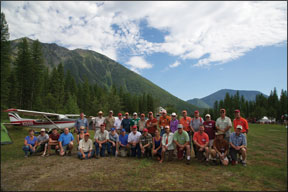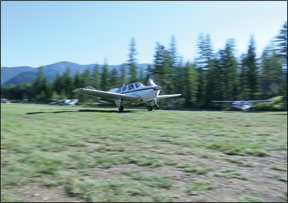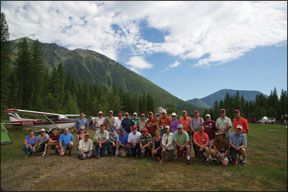Earlier this year, I passed the magical 1000 hours total time. I suspect I am safer. But whenever I read NTSB reports, they seem to cover the full range of pilot experience, so I have to question that assumption. Am I really safer or am I just likely to perform a different set of stupid pilot tricks to which pilots of my experience are prone?

288
I certainly feel safer than I did at 100 hours, when I was still intimidated with how to enter the pattern at an unfamiliar airport. I also feel safer than I was at 500 hours, when my big concern was being able to fly an approach in actual IMC and how to properly enter a holding pattern using my fresh instrument rating. I know I can do these now, so I am a bit less intimidated. But perhaps that intimidation kept me out of conditions where accidents are more likely.
Some Numbers
In 2010, 96 percent of the 1500 civilian aircraft accidents in the U.S. involved general aviation. According to the NTSB’s 2010 Annual Review of Civilian Aircraft Accident Data, the average pilot pursuing personal flying and who was involved in an accident had a “total flight time of 2863 total hours, with a range of 20 to 31,270 hours. The average time in the type of accident aircraft was 460 hours, with a range of 1 to 10,000 hours.”
Anybody with even a modest grounding in statistics can see a standard deviation and data variance big enough to fly a Twin Beech through. Meanwhile, a 2005 NTSB study of accident and non-accident pilots flying in the same area at the same time could not correlate experience with a higher accident rate, but did find the age at which a pilot earned his/her certificates to be a factor—younger is safer.
A 2002 epidemiological study of airline pilots by researchers at Johns Hopkins University found experience, measured by total flight time, offered a significant protective effect. With adjustment for age, Part 121 airline pilots with 5000 to 10,000 hours had a 57-percent lower risk of a crash than pilots with less than 5000 hours. The protective effect of flight experience, however, leveled off after total flight time reached 10,000 hours.
At my current average of 100 hours flying per year, I will achieve that safety plateau when I am 140. It is still instructive to look at research correlating pilot experience with NTSB accident data. Research examining the role of total flight experience and GA accident outcomes found that the pilots most at risk for an accident were either near their first thousand hours of flight time, like me, or between three to four thousand hours when they are more likely to be transitioning to increasingly sophisticated aircraft and more challenging flying conditions.
I have written about accidents involving pilots with more than 30,000 hours that I feel inoculated against by my own knowledge, training and experience. I also can say that I have witnessed pilots with far more experience than I have making pretty stupid aeronautical decisions. That said, I have also met student pilots with safety habits that put me to shame. So when, based on hours, can I claim to be at my theoretical safest level?
Perhaps the best understanding of safety actuarial data comes from the aviation insurance industry. While talking to my insurance broker and filling out a pilot experience form, I somehow developed the misguided belief that when I crossed the magical threshold of 500 hours or 1000 hours, my insurance rates would somehow cross into a “safe flyer” discount zone and my rates would drop like a Cub in a slip. It hasn’t entirely panned out that way because I am now building time in different aircraft and I am a relatively new conventional gear devotee without much tailwheel time.
Make and Model?
While it is true that pilots are penalized for having less than 100 or less than 500 hours, we really aren’t given much of an old-timer’s discount for surviving our “teenage” years. What does seem to drive our insurance rates is time in type.

288
Based on writings and policies of the aviation insurance industry, pilot experience in a specific aircraft make and model is considered a better measure of competency than total flight time. Insurance underwriters can favorably rank a 1000-hour pilot with 500 hours in the make and model with a 10,000-hour pilot who has no make and model experience.
Even though Avemco, like other insurers, offers better rates for pilots with more hours and more recent hours, their summer 2013 newsletter cites data suggesting this is against their own self-interest when it comes to ground-handling accident rates.
Avemco pointed out that taxi accident rates increased (to 13 percent) for pilots with more than 2500 hours total time. They ascribe this to complacency asserting that experienced pilots are likely to multitask while taxiing, thus increasing the chance for collision or excursion. The conclusion? The more gadgets you have in, on and around your panel, the more likely you are to be distracted while taxiing and bump into things. (Note to self: Add to bottom of pre-taxi checklist, “PUT DOWN THE GADGETS—this is not the Droid you’re looking for.”)
The Avemco piece also noted another inverse relationship. “Pilots who have less than 50 hours in make and model have the lowest rate of taxi mishaps. They are probably not comfortable enough yet with the airplane to let their eyes and minds wander during taxi. The rate of taxi claims goes up when the pilot has 50 to 100 hours in make and model.” Avemco noted that “The pilot who logs more than 100 but less than 500 hours in type has a moderate but still fairly low rate of taxi claims. Log more than 500 hours in type, however, and you may fall into the trap of complacency and avionics distraction that causes the taxi loss rate to soar.”
Self-Governing, Self-Deluding
At a recent flying event (the Recreational Aviation Foundation’s Donor Appreciation Fly-in at Ryan Field, Mon.), I discussed whether pilots with more total time are safer. Participants ranged from 120-hour pilots to those with more than 20,000 hours. The general conclusion was that pilots may be more experienced as they age, but don’t necessarily carry proficiency (and its brother safety) forward without active practice.
Jeanne MacPherson, a 6000-hour pilot, former Bureau Chief for Safety and Education, Montana Division of Aeronautics and now mountain flying and aerobatic instructor at Mountain Airdance (www.mountainairdancellc.com), suggested that safety comes with good habits and recurrent training. “More experienced pilots aren’t necessarily safer,” she said. “Staying attentive to the task of flying and knowing what to do when things don’t go according to plan requires training to develop the right reaction habits and practice to retain those habits.”
Retired airline captain Wayne Loeber, the pilot with the most hours at the RAF event (tipping the scales beyond 20,000 hours), suggested the secret to safety is pilot discipline. He cited the rigors of checklists, adherence to protocol and attentiveness to standard operating procedures found in the Part 121/135 and fractional-ownership world were what yielded a much better accident rate when compared with general aviation.
The speculation as to why experience measured by total hours and pilot accident rates don’t go hand in hand was often attributed to the fact that pilots are both self-governing and self-delusional. When fresh, we tend to establish our safety envelope conservatively and expanding the edges with caution. Student solo pilots are often given crosswind limits, but pilots also self-impose similar limits to stay in their comfort zone.
After getting my tailwheel endorsement, I studiously avoided crosswinds above 10 knots, but I slowly pushed the envelope beyond my early limitation. After 100 hours in the Cub, I am much more comfortable in crosswinds because I made a point of pushing the comfort zone. The last time I practiced crosswinds, I was landing Runway 17 with winds from 220 degrees at 20, with gusts to 30. I am more comfortable in crosswinds now but, ipso facto, I now have greater risk exposure because I am flying in winds that would have grounded me before. We also have to be careful about pushing the envelope to the point we find a hard edge. We mitigate one risk factor (crosswinds) and replace it with a new range of risks due to a longer list of acceptable behaviors.
This is where self-delusion comes in. As we add experience, we seem to add hubris in equal measure. A 100-hour pilot often frets over things a 10,000-hour pilot might blow off. For example and as Avemco pointed out, more experienced pilots worry less about taxiing, but that pattern applies elsewhere. More experienced pilots are also the ones who go out in more marginal weather, tackle more challenging aircraft, and are as likely to stretch gas reserves. The result is that more experience pilots seem to get bitten at about the same rate as newbies.
How Much or How Recent?
The insurance industry also seems to value recent flying experience. Insurance companies typically ask for flight times in the past 90, 60 or even 30 days. While they may not reveal sources and methods, underwriters give a great deal of credit for pilots with more recent time. The presumption is practice makes perfect, and pilots with more hours inside 90 days will be more proficient and therefore less prone to accidents.
Given that, one would think the assumption that recent pilot experience is a protective factor was backed by sound actuarial data, but a recent 2011 PhD dissertation rigorously examined the relationship between recent experience (in the prior 90 days) and accident rates for accidents in 2008. The upshot? There was no significant difference for pilots with more recent experience than pilots with stale experience.
The classic example found by Sarah Nilsson (now Dr. Nilsson) in her dissertation involved two accidents caused by carb ice. One pilot had one hour in the prior 90 days, while the other had logged 47 hours in the same period. According to the NTSB conclusions, they both crashed for the same reason—carb ice. The moral of the story is that flying more doesn’t necessarily inoculate you against an accident if you fail to apply carb heat. More experience doesn’t necessarily make you less fallible.
Secret Sauce?
With respect to analyzing pilot experience data, there are likely more ways to peel the onion back, and I suspect a finer-grained look at accident data and pilot experience would prove the insurance underwriters are making sound evaluations when they look at the combination of total hours, recent hours and time in type, along with variables like certificates, ratings and recurrent training.
In looking for the secret sauce to increase my safety and reduce my insurance rates, my the path forward is clear: I need to continue to fly more, fly more often, get more ratings and continue with recurrent training. No single one of these will keep me from having an accident, but the combination seems to offer the greatest protection. Of course, I am still waiting for that big break on my insurance, but I fly tail draggers, so no such luck.




